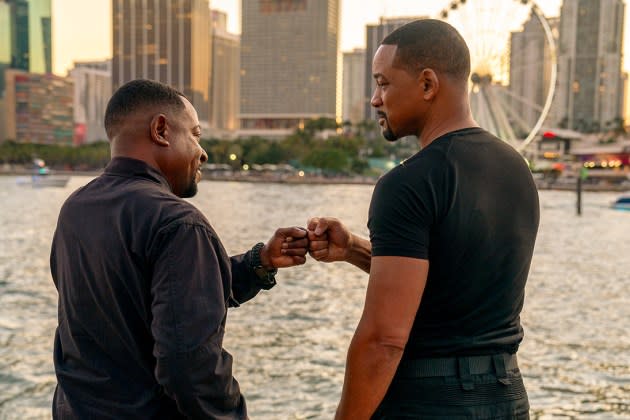‘Bad Boys: Ride or Die’ Review: Fourth Time Around, Will Smith and Martin Lawrence Can’t Hide the Strain

At one point in Bad Boys: Ride or Die, one of the principal characters announces, “This is some dysfunctional shit!” With self-aware comments like that, who needs film critics? Not that reviews will matter to the devoted fans of the action-comedy buddy cop franchise that began three decades ago and whose antecedents date as far back as 1974’s Freebie and the Bean and Busting (feel free to cite even earlier ones). It’s a durable concept, even if this fourth installment feels more than a little strained.
Watching Will Smith’s Mike and Martin Lawrence’s Marcus go through their familiar comedic bickering routines has become like spending an evening with a long-married couple whose constant sniping has grown wearisome. In the opening scene, Mike chides Marcus for his addiction to junk food and you think, “Again?”
More from The Hollywood Reporter
His concern proves apt, however, since not long afterward, while frenziedly dancing at Mike’s wedding, Marcus suffers a heart attack. He has a near-death experience, depicted in a hallucinatory sequence that feels like an outtake from 2001: A Space Odyssey, in which the now-dead Captain Howard (Joe Pantoliano) assures him, “It’s not your time.” A fully recovered Marcus wakes up in the hospital, tears off his IVs, and perches dangerously on the edge of the building’s roof, spouting New Age aphorisms that would make Marianne Williamson embarrassed, while baring his ass to all of Miami.
Marcus’ newfound spiritualism becomes the principal running joke of the film, and to say it wears thin is an understatement. Throughout the running time, Marcus acts ridiculously, to the point where he thinks he can simply repel a menacing alligator through force of will. Meanwhile, Mike understandably begins to suffer panic attacks, which become the film’s second most annoying plot element.
There are plenty of those in Chris Bremner and Will Beall’s at once simplistic and endlessly convoluted screenplay, revolving around the pair’s efforts to clear Captain Howard from posthumous corruption charges. They know he’s innocent not only because of their long friendship but also because they receive a prerecorded video message that Howard programmed to be sent in case anything happened to him.
This provides the opportunity for Pantoliano’s popular character to make a reappearance, although the film goes a bridge too far by also turning him into the equivalent of Obi-Wan Kenobi, popping up periodically in fuzzily photographed scenes in which he offers beneficent counsel like a rough-edged Dalai Lama.
The duo’s job becomes even harder when they’re accused of being criminals themselves (don’t ask, it’s complicated) and are forced to go on the run along with Mike’s son Armando (Jacob Scipio, returning from the previous film), who had been imprisoned for killing Captain Howard but is now a good guy.
It’s a staple of franchises like this and the Fast & Furious films: Characters arbitrarily switch from villains to heroes from film to film, and inevitably a major figure turns out to be a betrayer (hint, he or she is usually well-dressed). Another trend with long-running series is the growing proliferation of characters in each installment; this one feels so overpopulated that audiences should be given spreadsheets.
Numerous castmembers return, including Vanessa Hudgens and Alexander Ludwig as Mike and Marcus’ colleagues, now amusingly revealed to be in a romantic relationship. There’s also a cameo by Tiffany Haddish in which she’s not so amusingly allowed to let her freak flag fly.
The three fugitives are relentlessly pursued by every criminal in Miami after the principal bad guy (played by an intense Eric Dane, whose villainy is signaled by his impeccable bone structure) puts a $5 million bounty on their head.
Also on the trail is Captain Howard’s daughter, a U.S. Marshal who’s out for revenge on Armando for murdering her father. She’s played by Rhea Seehorn, who inexplicably goes unmentioned in the film’s press notes despite arguably being the best actor in the cast. Her casting continues the depressing trend of talented actors making the leap to uninteresting big-screen roles after finding fame on television. Her performance here is fine, but it pales next to her superbly nuanced work on Better Call Saul.
Anyhoo, it’s all an excuse for a series of high-octane action sequences, staged by returning directors Adil & Bilall (as Adil El Arbi and Bilall Fallah are billed), who seem eager to try out every technical flourish they could muster. They must have cornered the market on drones, since they’re used so often, both on-camera and off, that you begin to experience vertigo from all the swooping, swirling aerial shots.
The filmmakers also reveal a fondness for body cameras so you can experience the action viscerally, as if you’re playing a video game (a dubious achievement). The results look weird rather than immersive; one shot, involving Smith throwing a gun with a camera attached to Lawrence, is clearly meant to be virtuosic but just feels silly. The directors also indulge in so many tight close-ups that you can practically count the actors’ nose hairs.
That’s not to say there aren’t some impressive sequences, such as a fight aboard an out-of-control helicopter that’s as good as anything in the Mission: Impossible films. The single best scene, however, only features the main characters as onlookers, with the two of them helplessly staring at video monitors showing Marcus’ son-in-law Reggie (Dennis McDonald), now a strapping Marine, efficiently dispatching more than a dozen bad guys who have invaded Marcus’ home.
The combination of the terrifically choreographed violent mayhem and Smith and Lawrence’s hilarious reactions give a taste of what a better Bad Boys film could have been.
Best of The Hollywood Reporter